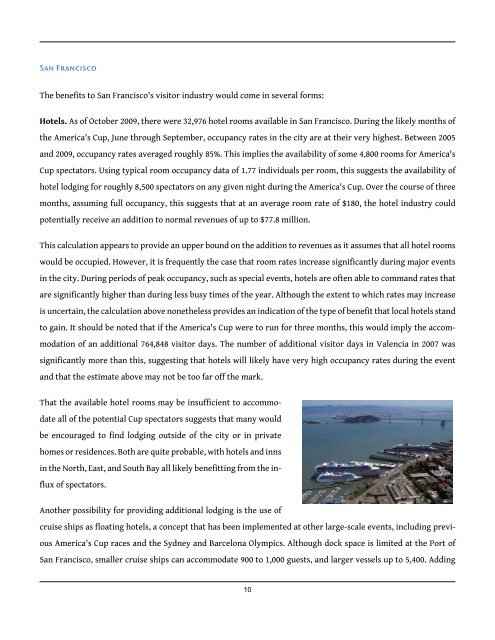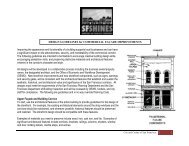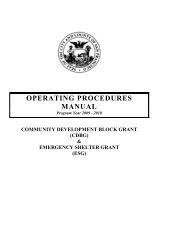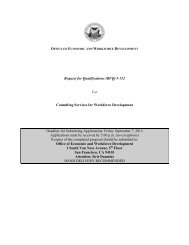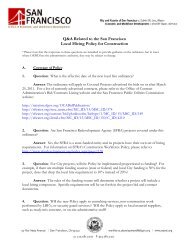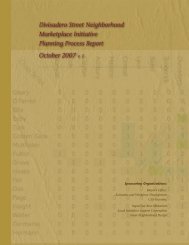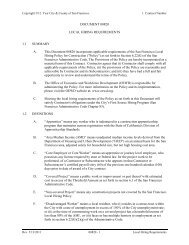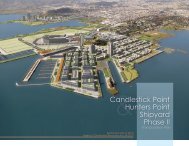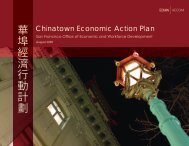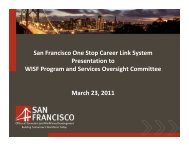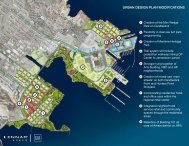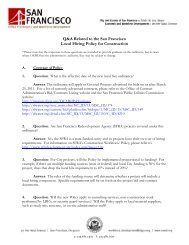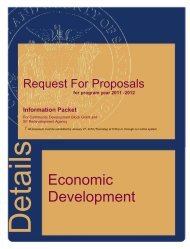The America's Cup: Economic Impacts of a Match - Bay Area Council
The America's Cup: Economic Impacts of a Match - Bay Area Council
The America's Cup: Economic Impacts of a Match - Bay Area Council
Create successful ePaper yourself
Turn your PDF publications into a flip-book with our unique Google optimized e-Paper software.
San Francisco<br />
<strong>The</strong> benefits to San Francisco's visitor industry would come in several forms:<br />
Hotels. As <strong>of</strong> October 2009, there were 32,976 hotel rooms available in San Francisco. During the likely months <strong>of</strong><br />
the <strong>America's</strong> <strong>Cup</strong>, June through September, occupancy rates in the city are at their very highest. Between 2005<br />
and 2009, occupancy rates averaged roughly 85%. This implies the availability <strong>of</strong> some 4,800 rooms for <strong>America's</strong><br />
<strong>Cup</strong> spectators. Using typical room occupancy data <strong>of</strong> 1.77 individuals per room, this suggests the availability <strong>of</strong><br />
hotel lodging for roughly 8,500 spectators on any given night during the <strong>America's</strong> <strong>Cup</strong>. Over the course <strong>of</strong> three<br />
months, assuming full occupancy, this suggests that at an average room rate <strong>of</strong> $180, the hotel industry could<br />
potentially receive an addition to normal revenues <strong>of</strong> up to $77.8 million.<br />
This calculation appears to provide an upper bound on the addition to revenues as it assumes that all hotel rooms<br />
would be occupied. However, it is frequently the case that room rates increase significantly during major events<br />
in the city. During periods <strong>of</strong> peak occupancy, such as special events, hotels are <strong>of</strong>ten able to command rates that<br />
are significantly higher than during less busy times <strong>of</strong> the year. Although the extent to which rates may increase<br />
is uncertain, the calculation above nonetheless provides an indication <strong>of</strong> the type <strong>of</strong> benefit that local hotels stand<br />
to gain. It should be noted that if the <strong>America's</strong> <strong>Cup</strong> were to run for three months, this would imply the accommodation<br />
<strong>of</strong> an additional 764,848 visitor days. <strong>The</strong> number <strong>of</strong> additional visitor days in Valencia in 2007 was<br />
significantly more than this, suggesting that hotels will likely have very high occupancy rates during the event<br />
and that the estimate above may not be too far <strong>of</strong>f the mark.<br />
That the available hotel rooms may be insufficient to accommodate<br />
all <strong>of</strong> the potential <strong>Cup</strong> spectators suggests that many would<br />
be encouraged to find lodging outside <strong>of</strong> the city or in private<br />
homes or residences. Both are quite probable, with hotels and inns<br />
in the North, East, and South <strong>Bay</strong> all likely benefitting from the influx<br />
<strong>of</strong> spectators.<br />
Another possibility for providing additional lodging is the use <strong>of</strong><br />
cruise ships as floating hotels, a concept that has been implemented at other large-scale events, including previous<br />
<strong>America's</strong> <strong>Cup</strong> races and the Sydney and Barcelona Olympics. Although dock space is limited at the Port <strong>of</strong><br />
San Francisco, smaller cruise ships can accommodate 900 to 1,000 guests, and larger vessels up to 5,400. Adding<br />
10


